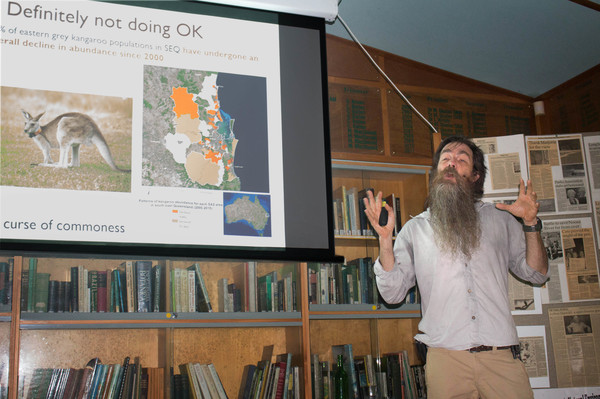By Margaret Maccoll
Peregian may be an Aboriginal word for emu but the iconic species doesn’t live here anymore and nor do quolls while eastern grey kangaroos and long-nosed potoroos may soon be following in their footsteps.
University of the Sunshine Coast ecologist Dr Scott Burnett told Noosa Parks Environment forum guests last Friday what he calls “the curse of commonness” was leading people to believe familiar wildlife still existed locally when their numbers were declining or extinct.
During 30 years of wildlife research Scott has studied the ecology of a suite of threatened species, including quolls, cassowaries, mahogany gliders, bettongs and stream frogs.
Scott said the greater Sunshine Coast region was home to 560 terrestrial wildlife species made up of 40 amphibians, 87 reptiles, 350 bird species and 83 mammals but many are not often seen by the public.
The Noosa area is a hotspot for frogs, venomous snakes and native rodents, he said.
Surprisingly species including the green tree frog and frill neck dragons have virtually disappeared and lace monitors,bearded dragons, death adders and eastern grey kangaroos are in decline.
Scott said some species prefer an open, dry understorey of bushland but in built up areas where fires reduce in incidence, the bush thickens and changes their habitat.
“They go through decline unnoticed as people think they’re around,” he said.
The key threats to wildlife are habitat loss, roads and a lack of knowledge, he said.
On the Sunshine Coast there is only a third of native bushland left and many urban developments are devoid of trees which removes the key habitats of mammals, snakes, birds and frogs which are the logs of trees which could take up to 50 years to grow if replanting occurs, he said.
Scott said landowners could help wildlife and turn their urban areas into wildlife sanctuaries by putting up nest boxes, restraining cats and dogs, planting native food trees, providing water and having messy yards containing structures for shelter. On a community level lobbying against to protect habitat and building fauna crossings over roads are ways to stop their declining numbers. The United Nations World Wildlife Day was celebrated on 3 March.







